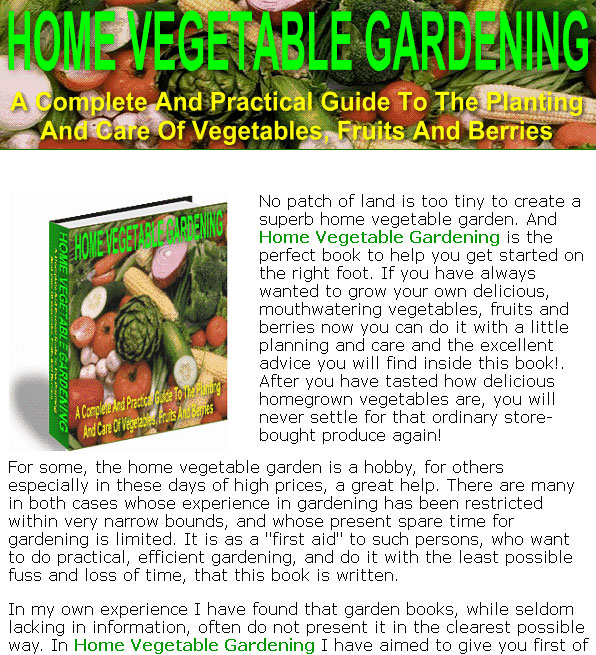Salespage Snapshot:

>>> Click Here To View Full Sales Page…
Table Of Contents
PART ONE
I INTRODUCTION
II WHY YOU SHOULD GARDEN
III REQUISITES OF THE HOME VEGETABLE GARDEN
IV THE PLANTING PLAN
V IMPLEMENTS AND THEIR USES
VI MANURES, FERTILIZERS AND MULCHING
VII THE SOIL AND ITS PREPARATION
PART TWO–VEGETABLES
VIII STARTING THE PLANTS
IX SOWING AND PLANTING
X THE CULTIVATION OF VEGETABLES
XI THE VEGETABLES AND THEIR SPECIAL NEEDS
XII BEST VARIETIES OF THE GARDEN VEGETABLES
XIII INSECTS AND DISEASE, AND METHODS OF FIGHTING THEM
XIV HARVESTING AND STORING
PART THREE–FRUITS
XV THE VARIETIES OF POME AND STONE FRUITS
XVI PLANTING; CULTIVATION; FILLER CROPS
XVII PRUNING, SPRAYING, HARVESTING
XVIII BERRIES AND SMALL FRUITS
XIX A CALENDAR OF OPERATIONS
XX CONCLUSION
Sample Content Preview
CHAPTER ONE
INTRODUCTION
Formerly it was the custom for gardeners to invest their labors and achievements with a mystery and secrecy which might well have discouraged any amateur from trespassing upon such difficult ground. “Trade secrets” in either flower or vegetable growing were acquired by the apprentice only through practice and observation, and in turn jealously guarded by him until passed on to some younger brother in the profession.
Every garden operation was made to seem a wonderful and difficult undertaking. Now, all that has changed. In fact the pendulum has swung, as it usually does, to the other extreme. Often, if you are a beginner, you have been flatteringly told in print that you could from the beginning do just as well as the experienced gardener.
My garden friend, it cannot, as a usual thing, be done. Of course, it may happen and sometimes does. You might, being a trusting lamb, go down into Wall Street with $10,000 and make a fortune. You know that you would not be likely to; the chances are very much against you. This garden business is a matter of common sense; and the man, or the woman, who has learned by experience how to do something, whether it is cornering the market or growing cabbages, naturally does it better than the one who has not. Do not expect the impossible. No, if you are going to take up gardening, you will have to work, and you will have a great many disappointments. All that I, or anyone else, could put between the two covers of a book will not make a gardener of you. It must be learned through the fingers, and back, too, as well as from the printed page. But, after all, the greatest reward for your efforts will be the work itself; and unless you love the work, or have a feeling that you will love it, probably the best way for you, is to stick to the grocery for your vegetables.
Most things, in the course of development, change from the simple to the complex. The art of gardening has in many ways been an exception to the rule. The methods of culture used for many crops are more simple than those in vogue a generation ago. The last fifty years has seen also a tremendous advance in the varieties of vegetables, and the strange thing is that in many instances the new and better sorts are more easily and quickly grown than those they have replaced. The new lima beans are an instance of what is meant. While limas have always been appreciated as one of the most delicious of vegetables, in many sections they could never be successfully grown, because of their aversion to dampness and cold, and of the long season required to mature them. The newer sorts are not only larger and better, but hardier and earlier; and the bush forms have made them still more generally available.
Other Details- 1 Ebook (PDF), 142 Pages
- 1 Salespage (HTML)
- Extras
- Year Released/Circulated: 2008
- File Size: 1,234 KB














